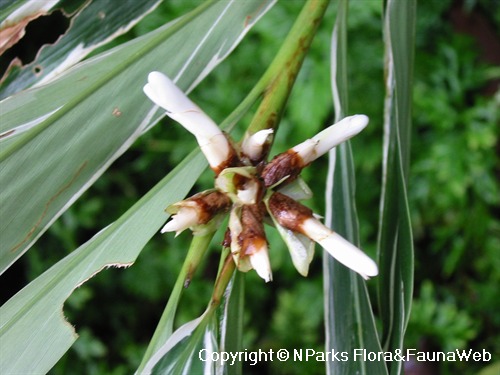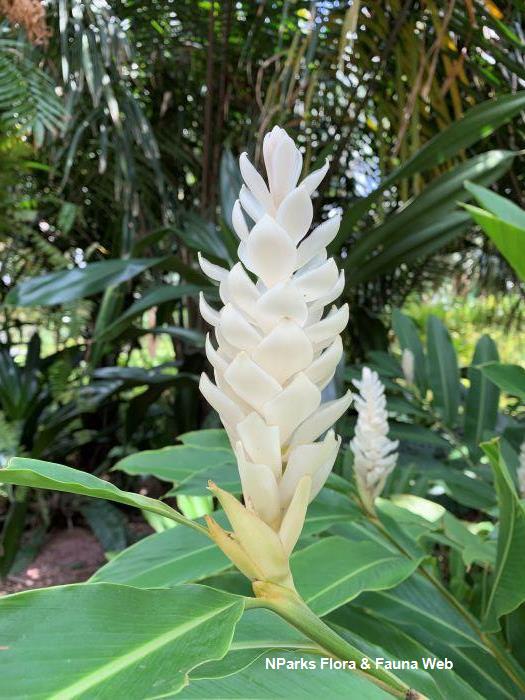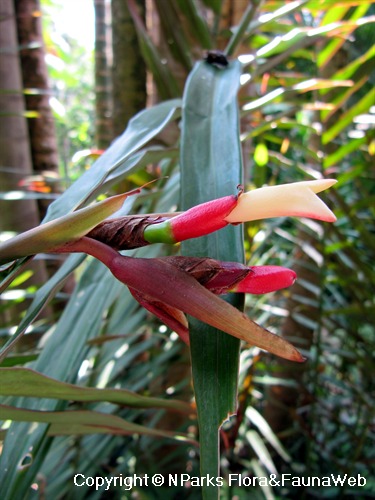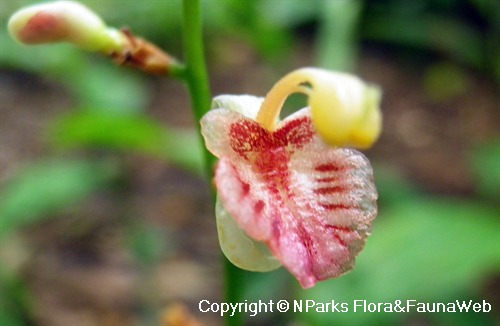
Back
Alpinia conchigera Griff.
| Family Name: | Zingiberaceae |
| Synonyms: | Languas conchigera Burkill |
| Common Name: | Lengkuas ranting, Lenkuas kecil, Lengkuas padang, Lengkuas geting, Chengkenam, 节鞭山姜 |
Name
Classifications and Characteristics
| Plant Division | Angiosperms (Flowering Seed Plants) |
|---|---|
| Plant Growth Form | Herbaceous Plant |
| Lifespan (in Singapore) | Perennial |
| Mode of Nutrition | Autotrophic |
| Plant Shape | Irregular |
| Maximum Height | 1.5 m |
Biogeography
| Native Distribution | Bangladesh, India, China (Yunnan), Cambodia, Laos, Myanmar, Thailand, Vietnam, Peninsular Malaysia, Singapore, Indonesia (Sumatra). |
|---|---|
| Native Habitat | Terrestrial (Agricultural Land, Secondary Rainforest, Freshwater Swamp Forest, Disturbed Area / Open Ground) |
| Preferred Climate Zone | Tropical, Sub-Tropical / Monsoonal |
| Local Conservation Status | Native to Singapore (Presumed Nationally Extinct (NEx)) |
Description and Ethnobotany
| Growth Form | Herb to 1.5m tall |
|---|---|
| Foliage | Leaves glabrous except for pubescence along leaf margin, and along the midvein on the under surface of the leaf. Young leaves with a glossy sheen. Leaf blades are oblong or lanceolate, 15-30cm by 1-10 cm. |
| Flowers | Corolla white, lip cream colored/ yellowish with reddish brown streaks, up to 1.5 cm long. In some specimens (mainly from China), the corolla is dark reddish brown. |
| Fruit | Pink or red fruits are round when fresh, oblong when dry, and 8-10 mm wide. Each fruit contains 3-5 seeds that are strongly aromatic. |
| Habitat | It grows in swampy areas, and open country near villages. |
| Associated Fauna | Its flowers are insect-pollinated. |
| Etymology | Alpinia, commemorating Prospero Alpino (1553-1616), an Italian botanist and professor of botany at Padua; Latin conchi, shell or shell-like, gera, carrying or producing. |
| Ethnobotanical Uses | Edible Plant Parts : Edible Fruits, Edible Storage Organs Food (Herb or Spice) Medicinal: In the Malay peninsular, a poultice of the boiled leaves, or a mixture of the leaves and rhizomes are applied externally as a treatment for rheumatism. The pounded leaves are also used as a poultice after confinement. In Chinese medicine, a boiled concoction of the rhizomes is taken to sooth indigestion, and a paste made from the punded rhizomes is used to treat insect bites. Others: Rhizomes are used to flavor rice wine (Indochina) and food (Northern Malaysia, Indochina). Also used as an anti-fungal medication in the east coast of Malaysia. |
Landscaping Features
| Landscaping | It is suitable for growing in parks, in wet places. |
|---|---|
| Desirable Plant Features | Ornamental Flowers |
| Landscape Uses | Parks & Gardens, Small Gardens, Riverine |
| Thematic Landscaping | Economic Garden |
Fauna, Pollination and Dispersal
| Pollination Method(s) | Biotic (Fauna) |
|---|---|
| Seed or Spore Dispersal | Biotic (Fauna) |
Plant Care and Propagation
| Light Preference | Semi-Shade |
|---|---|
| Water Preference | Lots of Water |
| Rootzone Tolerance | Moist Soils, Fertile Loamy Soils |
| Pest(s) | Sucking Insects |
| Propagation Method | Seed, Division |
Foliar
| Foliage Retention | Evergreen |
|---|---|
| Mature Foliage Colour(s) | Green |
| Mature Foliage Texture(s) | Smooth |
| Foliar Type | Simple / Unifoliate |
| Foliar Attachment to Stem | Petiolate |
| Foliar Shape(s) | Non-Palm Foliage (Lanceolate, Oblong) |
| Foliar Venation | Parallel |
| Foliar Margin | Entire |
Floral (Angiosperm)
| Flower & Plant Sexuality | Bisexual Flowers |
| Flower Colour(s) | Yellow / Golden, Red, Cream / Off-White |
|---|---|
| Flower Texture(s) | Thin |
| Flower Grouping | Cluster / Inflorescence |
| Flower Location | Terminal |
| Inflorescence Type | Spike, Raceme |
| Flowering Period | Free-Flowering |
| Flower Lifespan on Plant | Several Days |
Fruit, Seed and Spore
| Mature Fruit Colour(s) | Red |
|---|---|
| Fruit Classification | Simple Fruit |
| Fruit Type | Fleshy Fruit , Non-Accessory Fruit |
Image Repository
Others
| Master ID | 30895 |
|---|---|
| Species ID | 5272 |
| Flora Disclaimer | The information in this website has been compiled from reliable sources, such as reference works on medicinal plants. It is not a substitute for medical advice or treatment and NParks does not purport to provide any medical advice. Readers should always consult his/her physician before using or consuming a plant for medicinal purposes. |

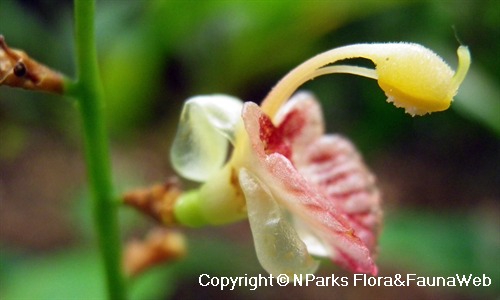
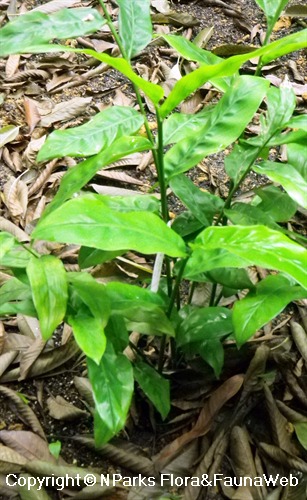
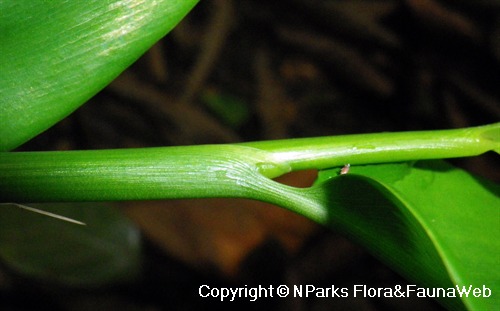
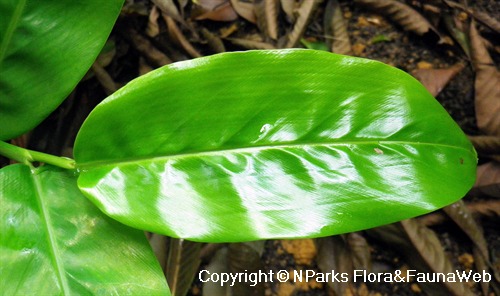
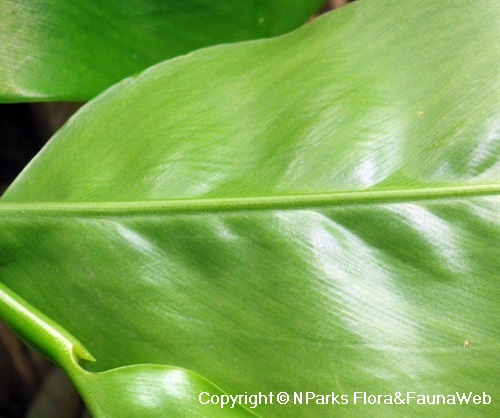
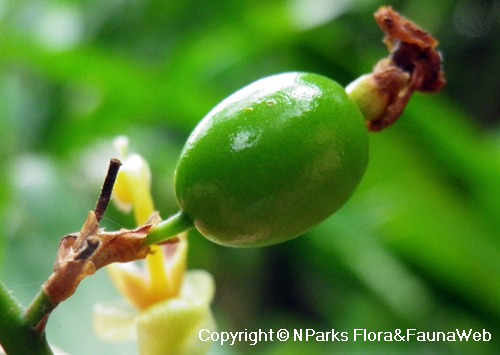
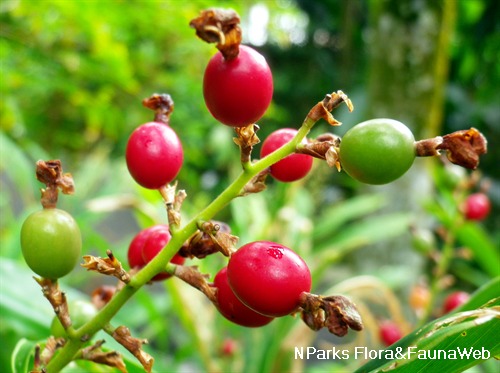
.jpg)
